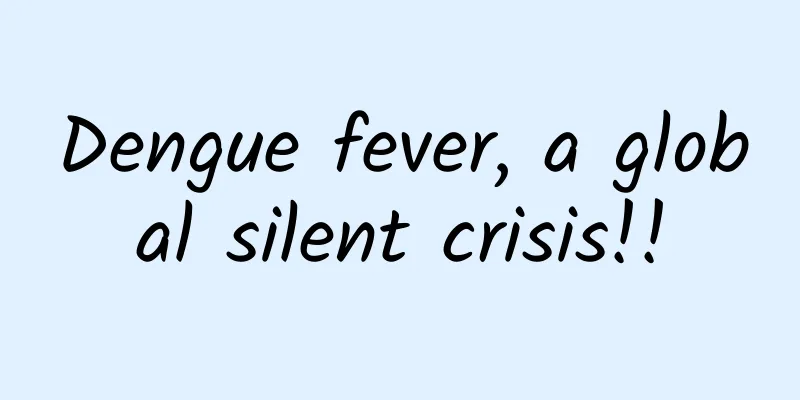Dengue fever, a global silent crisis!!

|
In the long and arduous struggle between humans and diseases, viruses are like ghosts, always haunting humans. Looking back, the sudden outbreak of the new coronavirus swept the world like a raging tsunami, bringing unprecedented turmoil and disaster to the world; the emergence of monkeypox has torn a new hole in the public health defense line of mankind; the rampant cholera has sounded a heavy alarm in some areas with poor sanitary conditions. And now, the resurgence of dengue fever has plunged the world into a new round of health crisis. It is no longer a public health event limited to a certain region, and its haze has spread to every corner of the world, forming a global, silent but extremely destructive crisis. Dengue fever is an acute infectious disease caused by the dengue virus, which is like a cunning enemy hiding in the dark. Its "accomplices" are Aedes aegypti and Aedes albopictus, the main vectors of dengue fever. These two mosquitoes are "masters" of survival. They can find suitable breeding places in indoor and outdoor environments in urban and rural areas. They especially prefer those seemingly harmless small containers of clean water, which are like their "nursery". Whether it is the stagnant water in the pots of aquatic plants carefully maintained at home, the little puddles left in the flower pot tray, or the rainwater accumulated in the waste tires discarded in the corner, or even the water stored in unused tanks, they have become ideal places for mosquitoes to lay eggs. After the mosquitoes lay eggs in these stagnant waters, after 8-12 days, the eggs will quietly hatch into adult mosquitoes, starting their sinful journey of spreading viruses. Dengue fever has a unique incubation period, generally 1-14 days, and in most cases 5-8 days. During this incubation period, the virus quietly grows in the patient's body, and the patient is often unaware of it. It is worth noting that patients are highly contagious from 1 day before to 5 days after the onset of the disease. When infected with dengue fever, the symptoms shown by the patient are somewhat similar to those of influenza, but also have their own distinct characteristics. This series of symptoms is vividly summarized as "high fever, three pains, and three reds" plus rash. "High fever" is one of the most significant symptoms. The patient's body temperature will suddenly rise sharply, even reaching above 40°C. This high fever burns the patient's body like a flame, causing great pain. The "three pains" refer to severe headaches, joint pains and muscle aches, which are like three sharp blades piercing the patient's body at the same time. The headache is like a splitting headache, the joints seem to be pierced by countless steel needles, and the muscles seem to be twisted and twisted, making the patient miserable. The "three reds" phenomenon - red face, red neck, and red chest, like a warning signal, appears on the patient's body. The rash usually appears on the limbs, trunk, head and face. These rashes are either congestive or punctate, like discordant "marks" growing on the body surface. In addition, some patients will also be affected by the digestive system, with symptoms such as nausea, vomiting, abdominal pain, and diarrhea. The combination of this series of symptoms makes the patient suffer greatly both physically and mentally. What is more worthy of attention is that there is a special situation of asymptomatic dengue fever. After these people are infected with dengue virus, there are no obvious signs of illness in their bodies, however, the virus is lurking in their blood. They are like "time bombs" hidden in the crowd, inadvertently spreading the virus to people around them through Aedes mosquitoes. This hidden way of transmission has greatly increased the difficulty of prevention and control, making it difficult for prevention and control personnel to grope in the dark and difficult to achieve comprehensive and effective prevention and control. Moreover, dengue virus is divided into 4 serotypes, which is like the virus has four different "disguises". When a person is infected with dengue fever for the first time, in most cases the symptoms are relatively less severe. After recovery, the body will produce immune antibodies to the serotype of dengue fever infected this time. But if you are unfortunately infected with another serotype of dengue virus again, the situation will take a sharp turn for the worse, and the body's immune system may overreact, which may lead to severe illness. Severe patients may suffer from serious consequences such as shock and organ failure, and their life safety is greatly threatened. From a global perspective, the incidence of dengue fever is showing a worrying and significant upward trend. In my country, there is a potential risk of local outbreaks of dengue fever in the southwest, southeast coastal and inland areas. Take Guangdong as an example. It has recently entered the peak period of dengue fever. The number of new cases in just 7 days is large, which undoubtedly puts great pressure on the local public health system. Fortunately, however, no deaths from dengue fever have been reported in my country so far. However, in some foreign regions, the situation is not optimistic. Especially in those high-incidence dengue fever areas in tropical and subtropical areas, the local medical conditions are limited, the prevention and control measures may not be perfect, and the people's awareness of prevention and control is relatively weak. These factors are intertwined, making the mortality rate of dengue fever in these areas high. Many patients have lost their lives due to the lack of timely and effective treatment, which has brought grief and loss to countless families. Faced with such a severe threat of dengue fever, the current medical field has not yet developed an effective drug, which is undoubtedly a major dilemma in prevention and control work. At present, the treatment of dengue fever is mainly symptomatic treatment and supportive treatment. In terms of symptomatic treatment, for high fever symptoms, a combination of physical cooling and drug cooling is generally used. Physical cooling can be done by using warm water sponge baths, focusing on wiping the patient's forehead, neck, armpits, groin and other parts rich in large blood vessels, taking away heat through the evaporation of water and lowering the body temperature. When the body temperature is too high, some antipyretic analgesics will also be used with caution, but care should be taken to avoid the use of drugs such as aspirin that may increase the tendency to bleed, because dengue patients are at risk of bleeding. For the "three pain" symptoms, appropriate analgesics can be given according to the degree of pain to relieve the patient's pain. For rashes, keep the skin clean and avoid scratching to prevent skin damage from causing infection. If the itching is severe, antipruritic drugs such as calamine lotion can be used externally. In terms of supportive treatment, timely rehydration is a key link. Since patients may lose a lot of water and electrolytes due to high fever, vomiting, diarrhea, etc., it is necessary to supplement physiological saline, glucose, etc. through oral or intravenous rehydration according to the patient's water loss, maintain water and electrolyte balance, and ensure the normal function of various organs in the body. At the same time, the patient's vital signs and changes in condition should be closely observed. For patients with bleeding tendency, active measures should be taken to prevent bleeding, such as using hemostatic drugs and supplementing coagulation factors. If the patient has severe complications such as shock, anti-shock treatment should be carried out immediately, including rapid rehydration, use of vasoactive drugs, etc., to maintain stable blood pressure and ensure blood perfusion of important organs. In addition, patients need to strictly prevent mosquito bites during treatment to avoid being bitten by mosquitoes again and spreading the virus, while also preventing newly infected mosquitoes from spreading the virus to other people. In terms of preventing dengue fever, the most important thing is to prevent mosquito bites. We can start from many aspects and take a series of effective measures to reduce the breeding and bites of mosquitoes. Keeping the living environment clean and hygienic is the foundation, which is like building a solid wall to resist mosquitoes. We should regularly clean the inside and outside of the house, not miss any corner where water may accumulate, and clean up those small accumulations that are easily overlooked in time to prevent mosquitoes from breeding. Installing screen doors and windows is to set up a physical defense line around the house to block mosquitoes outdoors. Mosquito repellent products such as mosquito nets, mosquito coils, and insecticides are like our "weapons" and play an important role in the fight against mosquitoes. Mosquito nets provide us with a safe space when we sleep, so that mosquitoes cannot get close to us; the smell emitted by mosquito coils can drive away mosquitoes and make them dare not approach; insecticides can directly kill those existing mosquitoes. When we go out, we also need to take protective measures. Try to wear light-colored long-sleeved clothes and long pants, because mosquitoes are often more easily attracted to dark objects, which can reduce the area of skin exposed to mosquitoes. At the same time, apply mosquito repellent on exposed skin. These repellents are like an invisible "protective film" that keeps mosquitoes away from us. In short, the resurgence of dengue fever has brought unprecedented severe challenges to global public health security. This is a war without gunpowder smoke, and each of us is a participant in this war. We must attach great importance to this issue. From the government to the community, from medical institutions to every ordinary citizen, we must strengthen the awareness of prevention and control. Only by working together and taking comprehensive and effective preventive measures to jointly respond to this silent crisis can we minimize the harm of dengue fever to human health and protect our healthy home. |
<<: Chronic obstructive pulmonary disease respiratory function training method
>>: The vitamin C "ceiling" in the fruit industry, many people may have never heard of it
Recommend
Why do I always feel like my brain isn't working enough? Seven eating habits slow down brain aging
Have you ever forgotten a word when you pick up a...
How to tell if you have sensitive skin
Every girl pursues beauty and wants to have fair ...
What is the thickness of the endometrium after ovulation?
We all know that women have a menstrual cycle eve...
Some little secrets of women's private parts
Many girls are shy about their private parts, but...
How long does it take for the belly to show?
I believe that most female friends will be very h...
What is the cause of the granules on the nipples?
The health of women's breasts needs special a...
Is the amniotic fluid still flowing?
If the amniotic fluid breaks during the due date,...
Can I eat Pi Ba during early pregnancy?
Loquat looks like a very unique fruit, but pregna...
What does a girl's private part look like?
Everyone's appearance and organs are differen...
Can I eat black fungus during menstruation?
Black fungus is actually fungus, and its color is...
What is the method to check fetal heart rate and embryo during pregnancy?
During the prenatal checkup, pregnant women shoul...
Oral Science - Wedge-shaped Defect
Author: Chen Yifujie, Xiang Tianzong, Chen Jiaqi,...
What to do if a breastfeeding mother has toothache
Breastfeeding mothers are most afraid of getting ...
What is uterine mucus?
The cervix of women secretes a kind of mucous gla...
Should I get the new coronavirus vaccine?
This article was first published by Hey Stone Hea...









